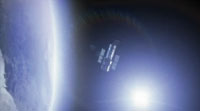 |
NASA | GSFC | JPL | Site Map |
|
|
 |
 |
Education: Student Outcomes |
Click here to search for other assets Climate Change and the Global Ocean: Viewing Phytoplankton From Space Grade level: 9-12 Theme: 21st century technology Video: global_ocean_02.flv
David Adamec: "We are dependent on life in the water. Especially in the ocean. There are small plants called phytoplankton that are responsible for 50 percent of the oxygen that you're breathing right now." Student Outcomes After viewing this video, students should be able to: Explain how new technology can enhance the gathering and manipulation of oceanic data. (T: 9-12) Key: C = climate / O = ocean circulation / T = 21st century technology / W = water cycle |
|||||
